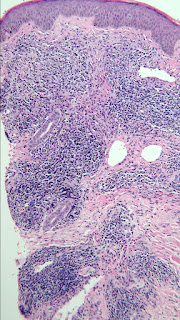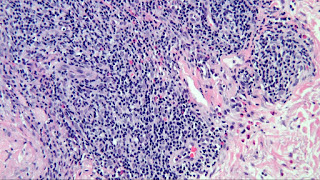The patient is a healthy 75 to man with a biopsy proven "evolving melanoma-in-situ" on the glabella. He has Type I skin. First seen and biopsied in April 2020.
4.20.2020
4.21.21
Question:
Should this be excised by an oncologic surgeon, by a Mohs surgeon, or is imiquimod acceptable?
Reference:
1.Topical Imiquimod for Lentigo Maligna: Survival Analysis of 103 Cases With 17 Years Follow-up. Meagan Chambers, et. al. J Drugs Dermatol 2021 Mar 1;20(3):346-348. PMID
2. Low recurrence rates for in situ and invasive melanomas using Mohs micrographic surgery with melanoma antigen recognized by T cells 1 (MART-1) immunostaining: tissue processing methodology to optimize pathologic staging and margin assessment
Jeremy Robert Etzkorn, Christopher J Miller . J Am Acad Dermatol. 2015 May;72(5):840-50. PMID
Follow-up:
The patient underwent micrographic surgery (with permanent sections). With one stage the tumor was cleared. Clinical Image 1 week post-surgery:






